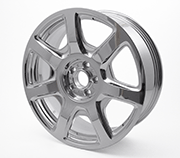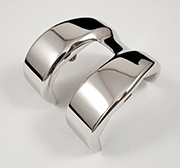E-Archive
Good Vibrations
in Vol. 20 - May Issue - Year 2019
Mass Finishing – A Hugely Important Aspect At The Centre Of The Value Chain

Forged alloy wheel after polishing operation

High end polished medical implant

Gear wheel after surface finishing operation
Although it used to be known as a “fringe technology” that was not really taken seriously, more and more manufacturers of metal and plastic components are recognising that mass finishing has developed into a major element of the production and value chain. Controllers, budget planners and marketers have recognised that innovative and smartly utilised mass finishing processes offer highly compelling sales potential.
In recent years many articles and columns have reported the enormous advancements made in equipment and process development. A great diversity of potential applications and the growth in the automation of equipment and processes have been met with resounding approval from engineers, technicians and production specialists around the world. At trade events and on the websites of leading suppliers, new processing methods are constantly being introduced, and much as it was during the digitalisation era, the frequency of new developments has increased many times over in the course of the past 20 years. In addition to successful machining results, the high process reliability and reproducibility of mass finishing processes is also widely recognised nowadays.
But what does this mean for the technology as a whole involved in the value chain of a component? What has changed, and where are we heading?
It’s first important to point out that there are of course still mass finishing processes that play only a minor role in the production process as a whole. For example, simple burr removal processes for punched or formed parts are possible for just a few cents and should actually be fairly inconspicuous due to the low overall production costs. Nothing has changed in this regard over the years. The main focus has been on the continuous advancement of automation with the aim of squeezing every last tenth of a cent out of the available cost-cutting potential.
However, the proportion of complex processes, sometimes accounting for the lion’s share of the overall production costs, has risen massively. In a variety of industries, applications for complex mass finishing processes have arisen over the past few decades. The complexity arises through an automated sequence of multiple machining stages, starting from the raw part produced as a result of the mechanical production process. An example of such a process sequence would be: Feed-in→Grease →Grind→Polish→Clean→Dry. The overall process is conducted in a largely automated fashion in accordance with defined parameters to ensure the reliability and reproducibility of the process. This means that production steps that used to involve a workpiece being passed through multiple departments are now performed in a single system. Reductions are achieved in not only production times but also in cost and human resource requirements.
In the value chain, such processes have become massively more important over the past two decades.
Here are a number of examples:
Automotive: In motor and drive technology the surface quality is a key factor in efficiency, engine balance, longevity and optimised performance. Throughout the entire drive engineering discipline, it is no longer uncommon for parameters and process data related to mass finishing processes to be anchored in the drawing or production specifications of a component.
Refined processes are used not only for functional aspects but also aesthetic features as well. Surface properties are hugely important both for the interior and for the exterior. Aluminium wheels, handles and other components are expected to be polished for that brilliant shine.
The more expensive the vehicle, the higher the quality standards and the more demanding the specific wishes of the customer. Where money is no object, high-tech processes are also used for a flawless surface finish.
Aviation and astronautics: Complex components and extreme day-to-day operating conditions necessitate perfect performance from all functional surfaces on the installed components. Safety is paramount, so no expense is spared in ensuring that components feature a perfect surface through their lifetime. Closely monitored, reliably reproducible processes are needed.
Medical engineering: Vibratory finishing processes that are complex, multi-stage, and largely automated are commonly used to produce a final surface finish, in particular for implants following their mechanical production. Because resilience and health risks are key issues in their later use, there is a willingness to employ highly complex processes in the interest of safety.
Food technology: In food processing, high-grade, long-lasting components made of stainless steel are used everywhere, requiring a very fine surface finish in the interest of hygiene, aesthetics and haptic sensation. Vibratory finishing processes have become increasingly established for ensuring that quality standards can be met through reliable processes.
Wind energy: Surface quality is also a key factor in efficiency, engine balance, longevity and optimised performance for gear systems in this field. Moreover, a crash or the replacement of individual components can be extremely costly, making the resistance of individual components to wear-and-tear essential.
These are just a few examples to illustrate why the value of surface finishes using mass finishing techniques has developed in the way that it has, resulting in greater attention and greater willingness to invest. Whereas there was previously little hesitation about investing little in vibratory finishing equipment or pushing it into the background, more is invested in it today as an "added value" technology that is installed and operated at the heart of production facilities.
Its impact is also felt in the services sector, with some specialist subcontractors offering such processes to provide companies unwilling to deal with mass finishing processes with the ability to outsource this aspect.
Overall, this is an encouraging development that will doubtless continue over the next 20 years.
Good Vibrations
by Dirk Gather
Contributing Editor MFN
and Managing Director of
surfaced GmbH, Germany
Tel. +49.3301.5232.0
Fax +49.3301.5232.29
E-mail: dirk@mfn.li



























